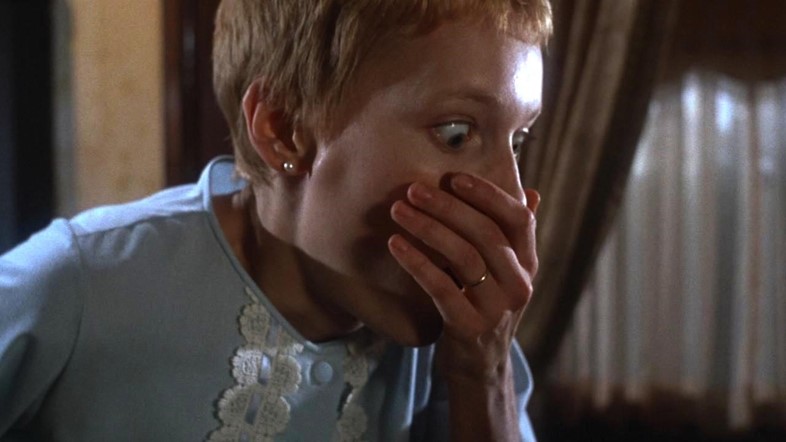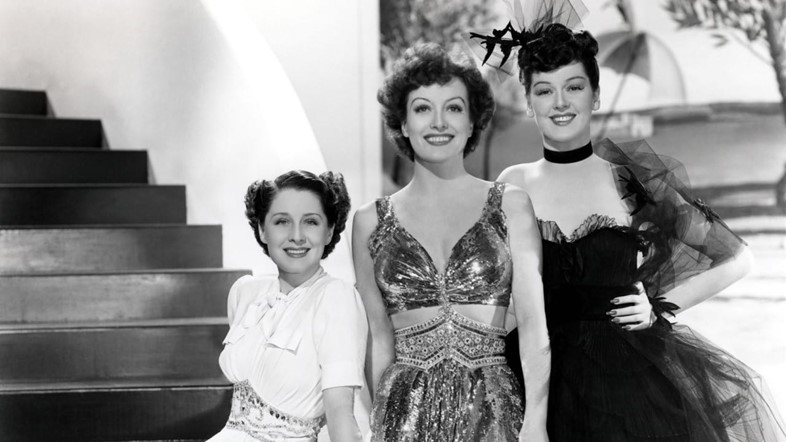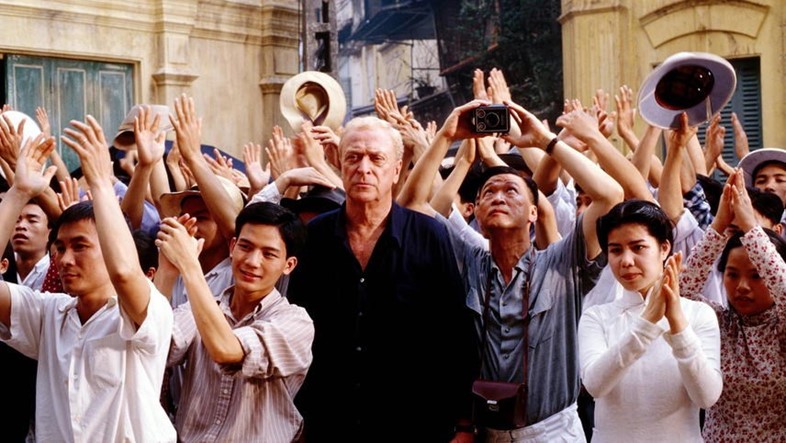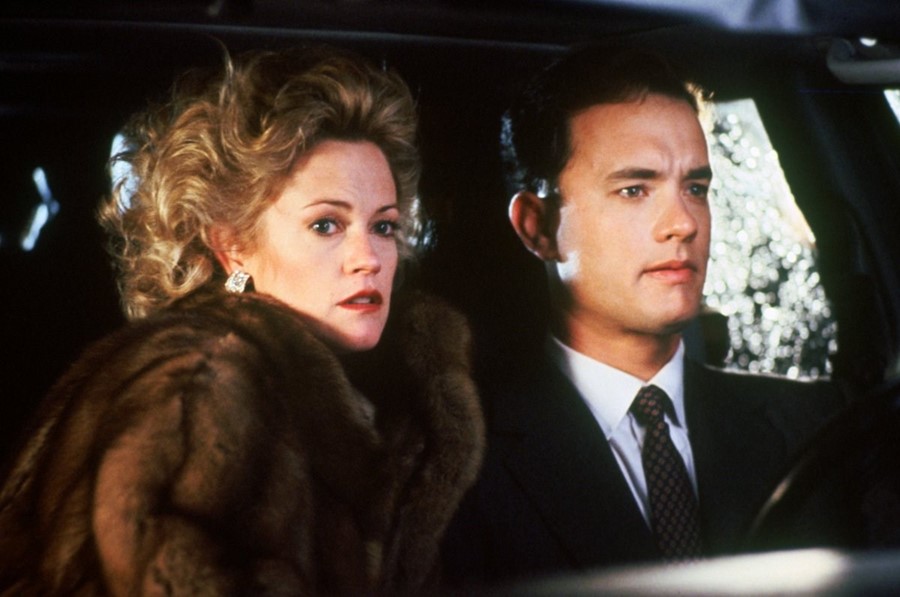Designers looked to a host of films to inform their collections – from 1930s Joan Crawford to the storied haircut of Mia Farrow in Rosemary’s Baby
The Spring/Summer 2019 collections proved that the celluloid screen is fertile ground for the fashion imagination – not least at Calvin Klein, where Raf Simons called upon Jaws and The Graduate in a collection which once again mused on the American dilemma. Here, five more films which defined the season, from New York to London to Milan.
1. The Bonfire of the Vanities (above)
The perennial appeal of the 1980s was demonstrated by the Mulleavy sisters at Rodarte, who brought to mind the moneyed, no-holds-barred party girls of the decade in their return to New York from Paris. Cue a frisson of gowns – in high-shine metallic fabric, point d’esprit or blousy florals – ruffled and amplified on the shoulders, or tied with ribbon bows, in the period’s outré style. As such, it drew parallels to Tom Wolfe’s novel The Bonfire of the Vanities, a satire on the gilded cynicism of the 80s which tells the cautionary tale of investment banker Sherman McCoy (self-proclaimed “Master of the Universe”) and his wealthy mistress, who take a wrong turn into a “warzone” Bronx neighbourhood, becoming involved in a hit and run which kills a black teenager. Since turned into a film starring Tom Hanks, it is an acerbic exploration of privilege, race, justice and wealth which feels particularly apropos for America’s given moment.

2. Angels in America
Ralph Lauren’s seasonal epic – this time marking 50 years of his eponymous label-cum-American institution and attended by Oprah Winfrey, Hillary Clinton and Steven Spielberg, among others – took place in New York’s Central Park, set against the backdrop of the Bethesda Fountain. A cultural landmark – appearing in countless films and television programs, including Annie Hall and Sex and the City – it is perhaps most poignantly recalled in Tony Kushner’s AIDS-era play, Angels in America: A Gay Fantasia on National Themes (later to become a two-part HBO movie, starring Meryl Streep). Named after the Bethesda Fountain in Jerusalem, which is believed to have been blessed by the angel Bethesda to have curative effects for those who bathe in it, it becomes symbolic of physical and cultural healing in the film. A suitably metaphor-laden spot – it was built to commemorate the fallen naval officers of the Civil War, who fought to oppose slavery – to celebrate a brand which has long bestowed the promise of the American dream.

3. Rosemary’s Baby
There are few hairstyles quite as mythologised as Mia Farrow’s pixie crop, first revealed to the world in 1968 psycho-horror Rosemary’s Baby. So the story goes: Vidal Sassoon was flown from London to the Paramount lot to cut Farrow’s hair, leading to him to quip it was the $5,000 haircut and purportedly causing the break-up of her and Frank Sinatra’s marriage, due to the latter’s dislike for women with short hair. (This was later rebuked by Farrow on Twitter – she had cut her hair two years previously herself and thus Sassoon’s appearance was simply a publicity stunt.) That super short style – particularly the signature inch-long fringe – was replicated in Miuccia Prada’s S/S19 show by hairstylist Guido Palau, prefiguring a collection which clashed conservatism with revolution. “I wanted to break the rules of the classic,” the designer said backstage. “To discuss a wish of freedom and liberation and fantasy, and, on the other side, the extreme conservatism that is coming – the duality out there.” As such, Rosemary – unknowingly impregnated with the spawn of Satan by her husband in order to further his own career – would seem an eerily prescient muse.

4. The Women
Those who witnessed the cool dystopia of sisters Laura and Deanna Fanning’s first collection for Kiko Kostadinov (and the brand’s debut womenswear collection) might be surprised to find that 1930s movie The Women, starring Joan Crawford, was on the moodboard. But the pair – also inspired by East German knitting patterns, and the colours of the caste system in Aldous Huxley’s seminal dystopic text, Brave New World – were transfixed when they watched a technicolour version of the Hollywood movie, enchanted by the strange glamour of Gilbert Adrian costumes for MGM. “They have this fashion show and it has all this occasionwear, but also tennis skirts,” they explained to AnOther. “It’s like these gowns mixed with 1940s sportswear and the proportions of tenniswear.” As such, garments – sometimes severe, and amplified on the shoulder – amalgamated glamour and sportswear to surreal effect (also on the moodboard was Rachael from Blade Runner, a suitably postmodern emblem).

5. The Quiet American
Earlier this year, designer A Sai Ta of label Asai returned to Vietnam after a almost decade, marking what he called a turning point in his brief but impactful career thus far. “I haven’t been to Vietnam in ten years and this was my third time visiting,” he told AnOther of the trip. “I saw my grandmother and spent lots of quality time with the rest of my family – it was great connecting with my culture. Vietnam has such a rich history, and it was really eye-opening being there again. I spent time in the National War Museum in Ho Chi Minh and learnt about the effect and aftermath of the Vietnam War.” As such, his woman was newly emboldened – clashing camouflage and military details (the nunchuck bag returned this season) with corset, monks’ robes and celebratory hues of orange, green, fuschia and turquoise. On the accompanying notes, Ta referenced Graham Greene’s The Quiet American (subsequently a film starring Michael Caine) as a providing a fitting metaphor – a love-triangle, in the midst of the Vietnam war, between American idealist Alden Pyle (the titular quiet American), British journalist Thomas Fowler and Vietnamese dancer Phuong – for a collection about the ambiguities of viewing a country from the outside.
